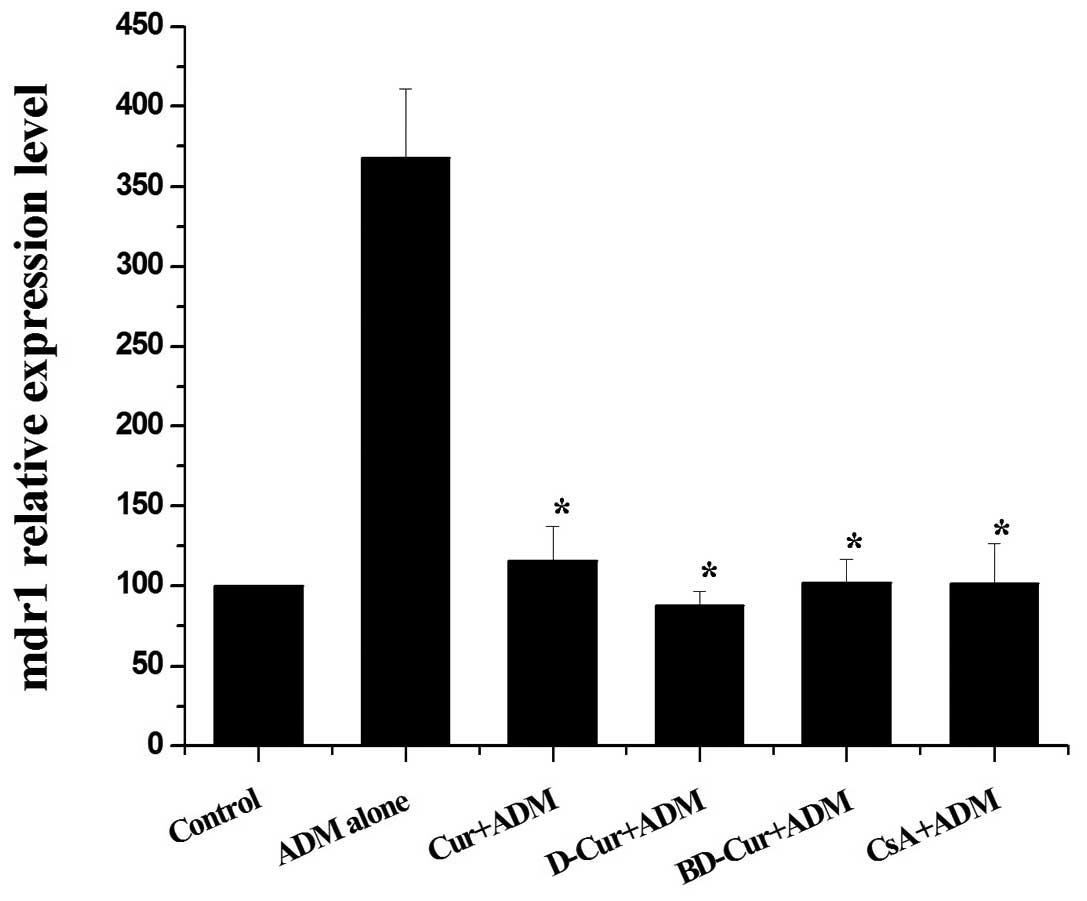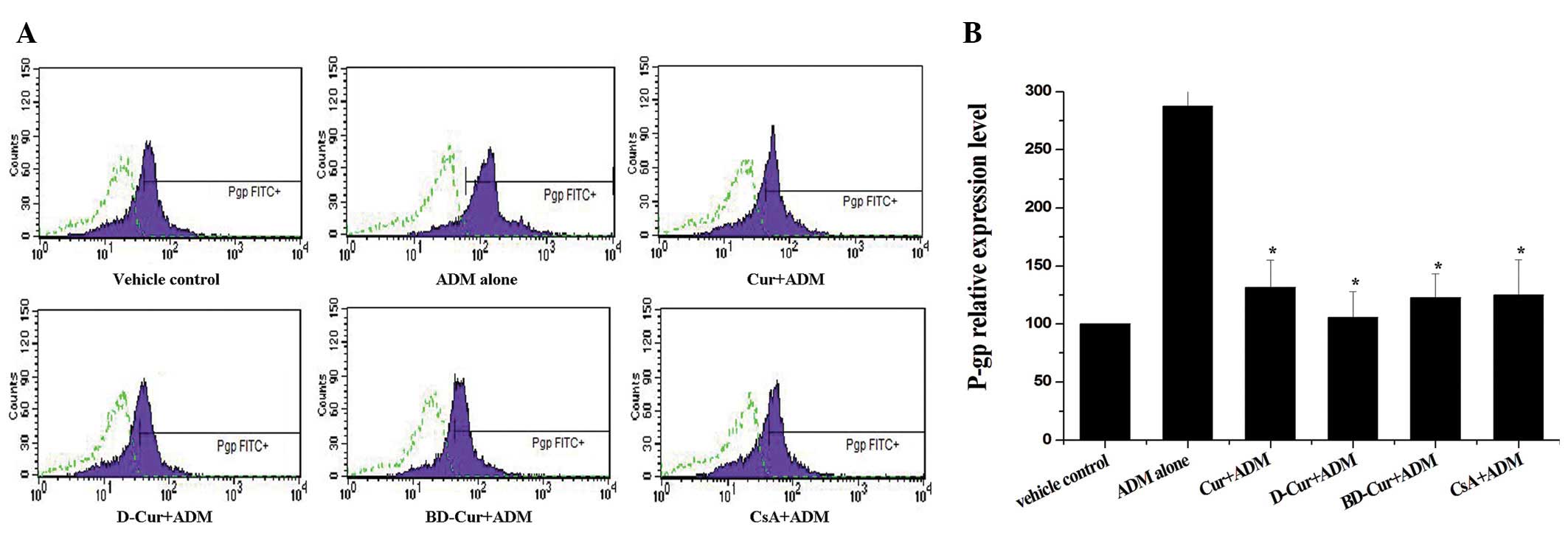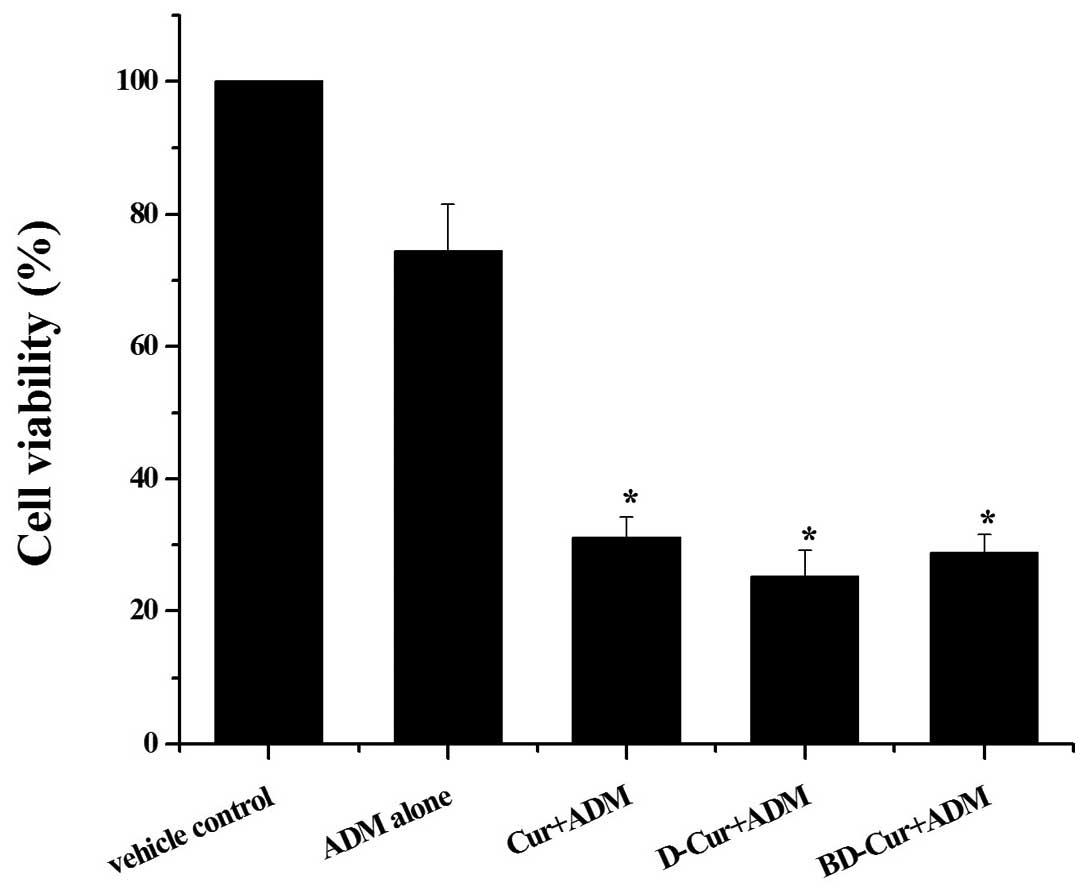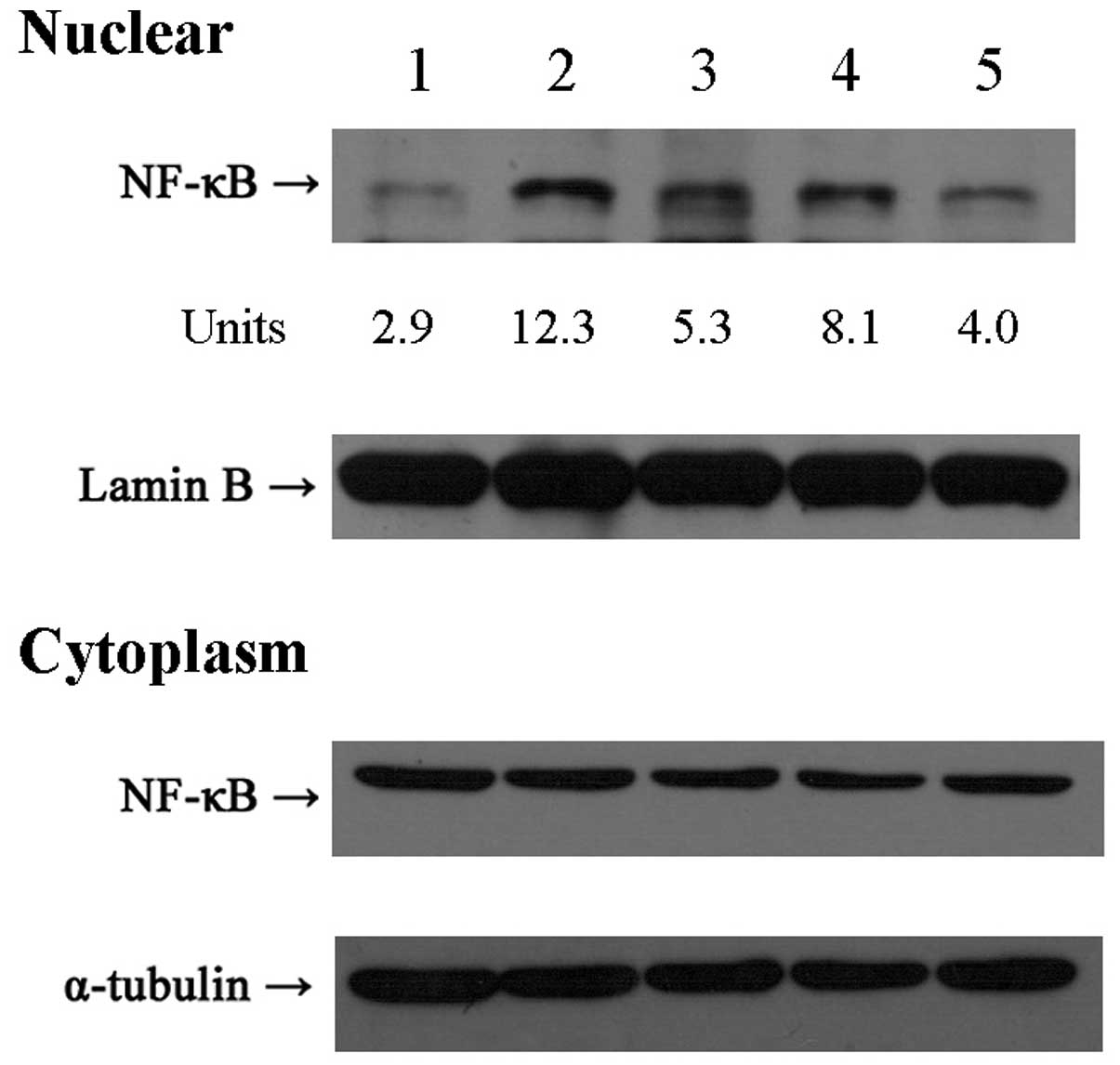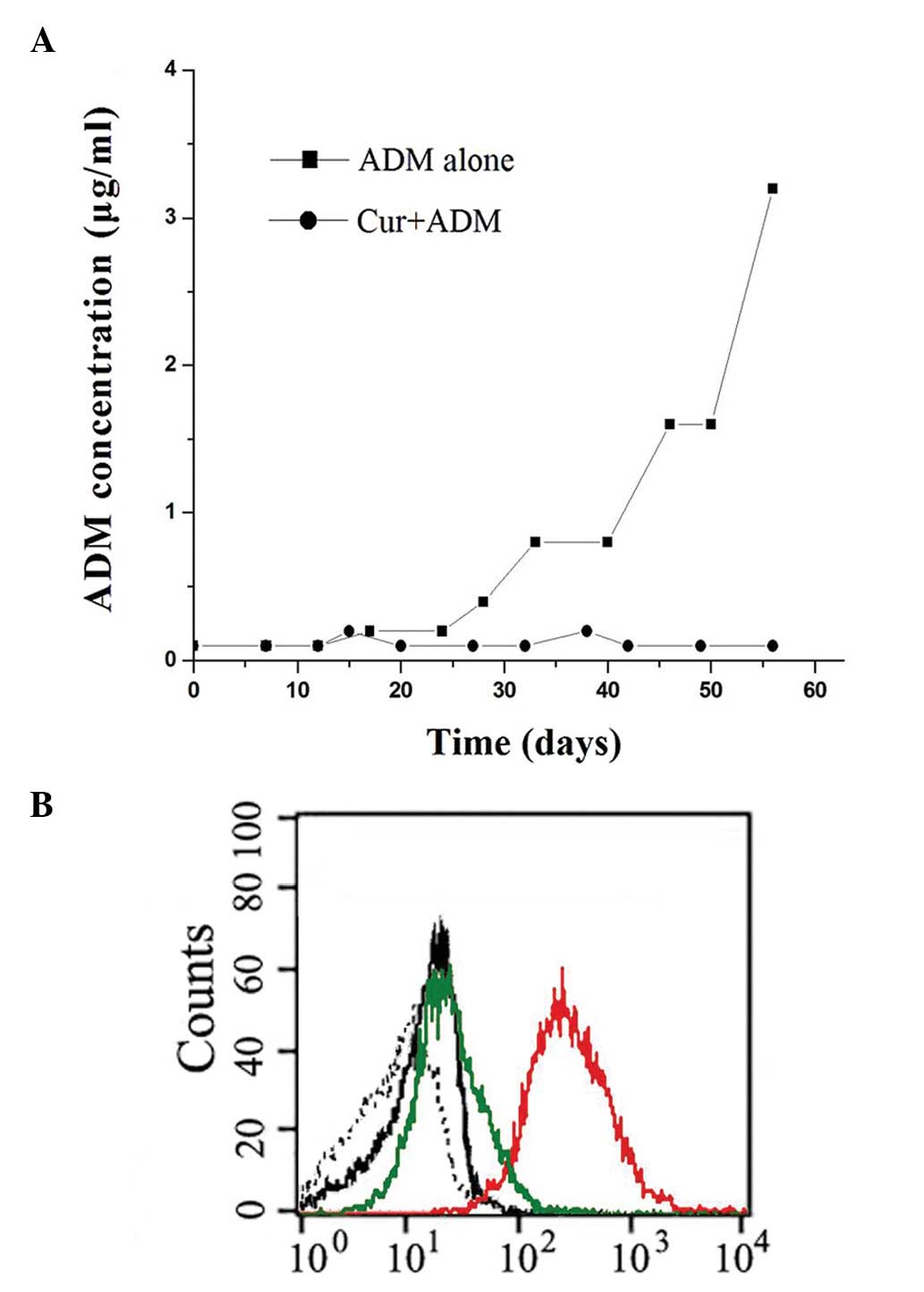P-gp upregulation may be blocked by natural curcuminoids, a novel class of chemoresistance-preventing agent
- Authors:
- Published online on: September 27, 2012 https://doi.org/10.3892/mmr.2012.1106
- Pages: 115-121
Abstract
Introduction
The presence or development of multidrug resistance (MDR) is the primary cause of chemotherapy failure in the majority of types of cancer. Overexpression of P-glycoprotein (P-gp) is the most frequent cause of MDR (1,2). Cancers sensitive to drugs initially are usually observed to become drug resistant due to the drug-induced upregulation of P-gp. Decreased response to anticancer drugs and poor treatment outcomes were associated with the overexpression of P-gp (3).
In our previous studies, we focused our emphasis on the ‘reversing’ effect of certain promising chemicals through the modulation of P-gp expression in MDR cancer cells. We reported for the first time that certain naturally occurring agents, such as honokiol and schisandrin B, are capable of reversing drug resistance through downregulating or inhibiting P-gp in MCF-7/ADR cells (4–6). However, with the progression of our research, we discovered that once MDR had occurred, it is hard to reverse, as the expression level of P-gp was markedly high and certain related targets such as anti-apoptotic signaling were activated (7,8).
P-gp elevation is usually the initial step leading to final MDR (8). Therefore, it would be ideal to prevent or block P-gp upregulation induced by anticancer drugs prior to the formation of MDR. This hypothesis led to us changing our research strategy. Our recently published report indicated a novel function of curcumin: it is capable of preventing acquired drug resistance induced by adriamycin (ADM) in K562 cells (9). This discovery was awarded the China patent in 2010 (X. Hu and D. Xu. The application of curcumin as a cancer MDR preventor. China patent application No. ZL 2007 1 0070320.4). However, curcuminoids contain at least three active forms: curcumin (Cur), demethoxycurcumin (D-Cur) and bisdemethoxycurcumin (BD-Cur). The chemical structures of these curcuminoids are shown in Fig. 1. Therefore, in the present study, we further examined the most active forms of curcuminoids present in turmeric as potent preventers of drug resistance and explored the possible mechanism underlying the preventive effect. We also developed an in vitro model to test the long-term preventive effect of curcumin.
Materials and methods
Reagents
Cur, D-Cur and BD-Cur were purchased from Ronghe Co. (Shanghai, China), with a purity of >99%; RPMI-1640 and fetal calf serum were purchased from Gibco-BRL (Invitrogen Co., Grand Island, NY, USA); MTT (3-(4,5-dimethylthiazol-2-yl)-2,5-diphenyltetrazolium bromide) and ADM were purchased from Sigma Chemical Co. (St. Louis, MO, USA); antibodies were purchased from Cell Signaling Technology Inc. (Danvers, MA, USA) and Santa Cruz Biotechnology Inc. (Santa Cruz, CA, USA); primer pairs and probe were purchased from Sangon Co. (Shanghai, China); TRIzol reagent and the RT-PCR kit were purchased from Invitrogen.
Cell lines and culture conditions
Human leukemia cell line K562 was maintained in RPMI-1640 containing 10% fetal calf serum. Cells were cultured at 37°C in a 5% CO2 humidified atmosphere.
RT-PCR determination of mdr1 mRNA
The mdr1 mRNA level was detected by quantitative real-time RT-PCR. K562 cells were seeded into 24-well plates at a density of 0.5×105/well with 5 μmol/l Cur, D-Cur, BD-Cur or cyclosporin A (CsA) for 24 h and then co-incubated with ADM (40 ng/ml) for another 48 h. In the vehicle control and ADM alone group, only 0.5% DMSO was used to pretreat K562 cells. Total RNA from K562 cells was isolated by TRIzol reagent according to the manufacturer’s instructions. Total RNA was reverse transcribed to cDNA and stored at -20°C. The sequence of TaqMan probe and primer pairs for mdr1 mRNA were described previously (10). Primers and probe for GAPDH were purchased from PE Applied Biosystems (TaqMan GAPDH Control Reagent kit; Foster City, CA, USA).
Quantitative real-time PCR was performed as described previously (4). In brief, mdr1 forward primer 5′-AGAAAG CGAAGCAGTGGTTCA-3′ and mdr1 reverse primer 5′-CGAACTGTAGACAAACGATG-AGCTA-3′ amplified a 90-bp fragment from the mdr1 cDNA that was detected by the TaqMan probe 5′-TGGTCCGACCTTTTCTGGCCTTAT CCA-3′. The reaction was performed in triplicate for each RT product. Samples were heated for 2 min at 50°C and 10 min at 95°C, followed by 40 cycles of amplification for 15 sec at 95°C and 1 min at 60°C. The fluorescent signal was determined using Sequence Detector™ software (PE Applied Biosystems), giving the threshold cycle number (CT) at which PCR amplification reached a significant threshold. The ΔCT value was defined as the difference in CT value for the mdr1 and GAPDH mRNA. Accordingly, ΔCT =(mdr1 mRNA CT) - (GAPDH mRNA CT), and the relative mdr1 mRNA expression level was presented as 2−ΔCT. Thus, the mRNA expression levels of mdr1 are expressed as concentrations relative to GAPDH mRNA.
Flow cytometry (FCM) analysis of P-gp expression
K562 cells were seeded into 6-well plates at a density of 2×105/well and then pretreated with 5 μmol/l Cur, D-Cur, BD-Cur or CsA for 24 h and then co-incubated with ADM (40 ng/ml) for another 72 h. In the vehicle control and ADM alone group, only 0.5% DMSO was used to pretreat K562 cells. For FCM analysis, cells were incubated with FITC-conjugated mouse anti-human monoclonal antibody (1:200 diluted) at 4°C for 1 h, then washed twice with ice-cold PBS and the level of fluorescent staining was analyzed using Beckman EPICS Flow Cytometry (Coulter Electronics, Hialeah, FL, USA).
Cytotoxicity assay
Cells were seeded into 96-well plates, and then pretreated with or without 5 μmol/l Cur, D-Cur and BD-Cur for 24 h, followed by addition of 80 ng/ml ADM, and then co-incubated for another 72 h. Finally, 20 μl MTT (5 mg/ml) was added to each well and the cells were incubated for another 4 h. Following aspiration of the culture medium, the resulting formazan was dissolved with 150 μl DMSO. The absorbance was read with a model ELX800 Micro Plate Reader (Bio-Tek Instruments, Inc., Winooski, VT, USA) at 570 nm.
Nuclear factor-κB (NF-κB) translocation detection
K562 cells were seeded into 6-well plates at a density of 1×106/well and then pretreated with 5 μmol/l Cur, D-Cur or BD-Cur for 30 min and then co-incubated with ADM (100 ng/ml) for another 30 min. In the vehicle control and ADM alone group, only 0.5% DMSO was used to pretreat K562 cells. For western blot analysis, cells were harvested for isolation of nuclear and cytoplasm extracts using the Nuclear Extract kit (Active Motif, Carlsbad, CA, USA). The concentration of the proteins was then determined by the standard BCA protein assay. Approximately 40 μg of each sample was loaded in gels for the immunoblot assay according to a standard protocol. The primary antibodies used were mouse monoclonal anti-human NF-κB and rabbit polyclonal anti-human lamin B and α-tubulin (Cell Signaling Technology Inc.), and the secondary antibody used was HRP-conjugated anti-rabbit IgG (Santa Cruz Biotechnology Inc.). The signal was visualized with HzfRP-conjugated secondary antibodies using ECL Plus Western Blotting Substrate (Thermo Fisher Scientific, Rockford, IL, USA). Antibodies to α-tubulin (a cytosol-specific protein) and lamin B (a nucleus-specific protein) were used as loading controls.
Culture of resistant cell lines
Resistant cell lines were cultured using the protocol of Cocker et al(11). In the ADM alone group, K562 cells were seeded into a 55-cm2 cell culture flask at a density of 2×106 cells and incubated in culture medium containing ADM at an initial concentration of 0.1 μg/ml. When the cells grew to confluence, they were collected and centrifuged for 5 min at 2,000 rpm, then 2×106 cells were reseeded, and the final concentration of ADM was doubled until the endpoint of the culture.
In the combined group, 5 μmol/l Cur was used for prevention of drug resistance. Cur was added to the culture medium 2 h prior to the ADM. The above two cell lines were analyzed for P-gp expression with FCM.
Statistical analysis
Data were expressed as the means ± SD, and analyzed using one-way ANOVA. Statistical analysis was performed with the SPSS 11.0 statistical analysis software. P<0.05 was considered to indicate a statistically significant difference.
Results
Preventive effects of Cur, D-Cur and BD-Cur on mdr1 mRNA upregulation
Real-time RT-PCR was used to compare the different preventive effects of Cur, D-Cur and BD-Cur on the mdr1 mRNA upregulation caused by short-term exposure to ADM. As Fig. 2 shows, in the ADM alone group, the mdr1 mRNA expression level increased markedly when induced by ADM. In the combined treatment groups, the induced mdr1 mRNA expression was blocked. D-Cur was the most active of the three curcuminoids for prevention of mdr1 mRNA upregulation, followed by BD-Cur and then Cur. BD-Cur had similar preventive potency on mdr1 mRNA expression as CSA. After statistical analysis, we found that there were significant statistical differences between the ADM alone group and four combined treatment groups (P<0.05), and no statistical significance could be observed between the Cur, D-Cur and BD-Cur combined groups and the CsA combined group (P>0.05). The above results indicated that Cur, D-Cur and BD-Cur were capable of blocking the upregulation of mdr1 mRNA expression induced by ADM, and D-Cur was the most active compound, followed by BD-Cur and then Cur. The preventive effects of the three curcuminoids were similar to CsA, which was the positive control used in the study.
Preventive effects of Cur and its derivatives on P-gp upregulation
Upregulation of P-gp was the most frequent reason for intrinsic and acquired drug resistance. To prove whether the preventive effect of curcuminoids on mdr1 mRNA upregulation was also associated with its encoded protein, P-gp, we then further separated the same groups and tested the P-gp expression by FCM. As expected, a notably elevated P-gp expression level was also observed after the short-term exposure to ADM alone (Fig. 3). However, in the combined treatment groups, the P-gp upregulation induced by ADM was partly blocked by Cur, D-Cur and BD-Cur. Similar to the previous RT-PCR results, D-Cur had the most active preventive effect on P-gp upregulation, followed by BD-Cur and then Cur. Statistical analysis indicated a significant difference between the four combined treatment groups and the ADM alone group (P<0.05). No significant difference could be observed between the Cur, D-Cur and BD-Cur combined groups and the CsA combined group (P>0.05). These results suggested that short-term exposure of native K562 cells to ADM resulted in not only elevated mdr1 mRNA expression (Fig. 2) but also increased P-gp upregulation (Fig. 3). Cur and its derivatives could clearly prevent acquired resistance triggered by ADM short-term exposure.
Effects of curcuminoids on the sensitivities of K562 cells towards ADM
The results above demonstrated that Cur, D-Cur and BD-Cur have the potency to block the expression of mdr1 mRNA and its encoded P-gp induced by short-term exposure to ADM. To further confirm the enhancing effects of the three curcuminoids on ADM-induced cytotoxicity, we performed an MTT colorimetric assay to assess cell viability. As shown in Fig. 4, pretreatment of K562 cells with Cur, D-Cur and BD-Cur notably enhanced the sensitivity of native K562 cells towards ADM. The mean cell viability detected by MTT decreased sharply from 75% (ADM alone) to 31% (Cur-pretreated), 25% (D-Cur-pretreated) and 29% (BD-Cur-pretreated), respectively. Taking the above results together, we hypothesized that the curcuminoid-enhanced ADM-induced cytotoxicity to K562 cells may be partly due to the blocking of the upregulation of P-gp, the transmembrane drug pump.
Western blot analysis detection of NF-κB in nuclear and cytoplasm extracts
As a transcription factor, NF-κB exhibits transcriptional activity when it is translocated into the nucleus. We detected the expression of NF-κB in the nuclear and cytoplasm extracts (Fig. 5) by western blot analysis to explore the effect of curcuminoids on NF-κB nuclear translocation. Following standardization with the internal control, the densitometric units of nuclear NF-κB bands in the five groups were 2.9, 12.3, 5.3, 8.1 and 4.0, respectively. Consistent with mRNA and P-gp expression, nuclear NF-κB translocation was markedly increased in the ADM alone group. However, in the combined-treatment groups, nuclear NF-κB translocation was markedly inhibited. Among the three curcuminoids, BD-Cur was the most active for inhibiting the nuclear translocation of NF-κB induced by ADM, followed by Cur and then D-Cur.
Effect of Cur on blocking the development of the drug-resistant cell line
Cocker et al(11) had successfully developed a cell line model for the acquisition of resistance to vincristine, and tested several chemical agents for their capabilities to prevent the acquisition of drug resistance. In our study, we conducted two independent experiments simultaneously according to a set protocol. As shown in Fig. 6A, the K562 cell line acquired drug resistance rapidly in the ADM alone group during the 56-day culture period, and finally, a resistant cell line emerged. This cell line was capable of tolerating ADM at a final concentration of 3.2 μg/ml, 32-fold higher than the initial concentration. In the combined group, Cur was shown to have the predominant preventive ability and the acquired resistance did not develop during the same culture time. We further compared the P-gp expression of the above two groups by FCM. Fig. 6B showed that ADM alone led to marked upregulation of P-gp level (red), while combined Cur pretreatment blocked the upregulation (green), and recovered the P-gp level close to the vehicle control group level (black).
Discussion
The wild-type K562 cell line normally expresses very low levels of mdr1 mRNA and P-gp, and has been characterized extensively on the phenomenon of MDR, as well as the function of P-gp (12,13). Therefore, we decided to use this cell line to assess the preventive effect of Cur and its derivatives on the expression of P-gp. CsA has been reported to have the capacity to inhibit the induction of P-gp expression in K562 cells (14), therefore it appears to be a useful positive control for our present study.
Curcuminoids are a class of natural phenolic coloring compounds found in the rhizomes of Curcuma longa Linn., commonly known as turmeric. The major curcuminoids present in turmeric are curcumin (Cur), demethoxycurcumin (D-Cur) and bisdemethoxycurcumin (BD-Cur). Previous studies have suggested that curcuminoids have enormous potency in the prevention and therapy of cancer. Su et al reported that Cur is capable of inducing apoptosis and cell cycle arrest in human colon carcinoma (15). Lin et al found that Cur inhibits angiogenesis and tumor growth in ovarian cancer cells by targeting the NF-κB pathway (16). Notably, its two derivatives, D-Cur and BD-Cur, were proven to have more potency than Cur in decreasing cell proliferation, inducing apoptosis and inhibiting cancer invasion (17,18). Additionally, researchers also reported that curcuminoids are capable of reversing MDR by downregulating the expression of drug resistance proteins such as P-gp (19,20) and MRP1 (21,22). In conclusion, curcuminoids were formerly considered as a class of promising anticancer or drug resistance-reversing agents, but not as a novel class of chemoresistance-preventing agents.
Recently, our latest report (9) demonstrated that Cur exhibits a novel function of preventing chemoresistance. We found that ADM treatment of K562 cells markedly elevated the expression of P-gp and induced the occurrence of drug resistance. However, following Cur pretreatment, the P-gp and mdr1 mRNA upregulation induced by ADM was significantly inhibited. This result suggested that Cur has dual function as a drug resistance inhibitor, not only ‘reversing’ but also ‘preventing’ acquired drug resistance. In the present study, we have extended the above findings and compared the preventive effect of each curcuminoid on the induction of drug resistance. Similar to previous studies, we found that all the three curcuminoids are capable of preventing the acquired drug resistance induced by ADM in K562 cells, but the preventative effect of each curcuminoid was different.
Historically, many studies concerning cancer MDR have proved that numerous chemicals have the potency to reverse MDR in drug-resistant cell lines. However, only a few of them, such as CsA and PSC833, are capable of working as a dual drug resistance modulator, not only reversing MDR in drug-resistant cells, but also preventing chemoresistance in native cells (14,23). In our previous studies, we reported for the first time that two naturally occurring compounds, honokiol and schisandrin B, are capable of reversing MDR through downregulating (4) and inhibiting P-gp (5) separately, but neither of them work as a drug resistance preventer (data not shown). In the present study, we introduced Cur and its derivatives as a novel class of chemoresistance preventer with the dual function of MDR modulation.
The mechanism of curcuminoids as bi- rather than mono-modulators was unclear until now, but may be partly related to the NF-κB nuclear translocation and activation, after which the downstream target genes, such as mdr1, were regulated (12,24). NF-κB has now been implicated in carcinogenesis, invasion, metastasis and the development of drug resistance in cancer cells. As a transcription factor, NF-κB exhibits transcriptional activity when it is translocated into the nucleus. Several studies demonstrated that mdr1 gene expression could be regulated by NF-κB (25). Cur is an efficient inhibitor of NF-κB since it inhibits NF-κB activation in multiple human carcinomas. Lin et al reported that Cur inhibits tumor growth and angiogenesis in ovarian carcinoma by targeting the NF-κB pathway (16). Kunnumakkara et al suggested that Cur potentiates the antitumor effects of gemcitabine in pancreatic cancer by suppressing proliferation, angiogenesis, NF-κB and NF-κB-regulated gene products (26). In our present study, results from western blot analysis showed that ADM treatment of K562 cells apparently increased the nuclear translocation of NF-κB. However, after pretreatment with Cur or its derivatives, the nuclear NF-κB translocation was inhibited markedly. This result demonstrated that Cur and its derivatives could inhibit the ADM-induced increase of NF-κB nuclear translocation and activation, and may be part of the mechanism underlying the preventive effect of curcuminoids on acquired drug resistance.
In the majority of research, Cur was found to be the most active of the three derivatives present in turmeric (26–28), while in certain studies BD-Cur exhibited the highest activity (20). Certain data also suggested that the mixture of all three is more potent than either one alone (20). Our present results did not closely correspond with the previous reports: results from RT-PCR and FCM showed that D-Cur was the most active of the curcuminoids for prevention of mdr1 mRNA and P-gp upregulation, followed by BD-Cur and then Cur. However, results from western blot analysis showed that BD-Cur was the most active agent in inhibiting the ADM-induced increase of nuclear NF-κB translocation, followed by Cur and then D-Cur. This ranking did not correlate with the trend of the drug resistance-preventing activity of the three curcuminoids and supports the theory that the activity of preventing drug resistance was not necessarily proportional to the activity of inhibiting NF-κB translocation.
Previously, Cocker et al had established a preclinical model for the development of drug resistance to vincristine (11). Therefore, in our study, we conducted two independent experiments simultaneously according to a set protocol. After 56 days of culture, native K562 cells acquired drug resistance rapidly in the ADM alone group and could tolerate ADM at a 32-fold higher level than the initial culture concentration. However, in the combined group, after 5 μmol/l Cur pretreatment, the development of drug-resistant cells was blocked during the same culture time and the ADM-induced P-gp upregulation was markedly reduced. This experiment strongly indicated that the development of drug resistance may be preventable using curcuminoids not only after short-term but also after long-term exposure of native cancer cells to ADM. Thus, chemoresistance prevention should be considered in the early course of chemotherapy, particularly among patients whose cancers are newly diagnosed and potentially drug sensitive. Therefore, in the clinic, treatment combining chemotherapy drugs with resistance-preventing agents may reduce the appearance of resistant MDR subclones and lead to a longer disease-free survival.
As for the potency of curcuminoids in preventing P-gp-mediated drug resistance, it is at least comparable to CsA. However, curcuminoids were superior to CsA, since at effective concentrations, curcuminoids do not have severe side effects like CsA, such as immunosuppression and renal toxicity (23). In conclusion, curcuminoids are a novel class of potent chemoresistance-preventing agents with low toxicity, high safety and potential for wide clinical use.
Acknowledgements
The authors acknowledge financial support from the National Natural Science Foundation of China (No. 30901741) and the Zhejiang Provincial Natural Science Foundation of China (No. 2080308).
References
|
Cole SP, Bhardwaj G, Gerlach JH, et al: Overexpression of a transporter gene in a multidrug-resistant human lung cancer cell line. Science. 258:1650–1654. 1992. View Article : Google Scholar : PubMed/NCBI | |
|
Gottesman MM, Fojo T and Bates SE: Multidrug resistance in cancer: role of ATP-dependent transporters. Nat Rev Cancer. 2:48–58. 2002. View Article : Google Scholar : PubMed/NCBI | |
|
Schinkel AH and Jonker JW: Mammalian drug efflux transporters of the ATP binding cassette (ABC) family: an overview. Adv Drug Deliv Rev. 55:3–29. 2003. View Article : Google Scholar : PubMed/NCBI | |
|
Xu D, Lu Q and Hu X: Down-regulation of P-glycoprotein expression in MDR breast cancer cell MCF-7/ADR by honokiol. Cancer Lett. 243:274–280. 2006. View Article : Google Scholar : PubMed/NCBI | |
|
Pan Q, Lu Q, Zhang K and Hu X: Dibenzocyclooctadiene lingnans: a class of novel inhibitors of P-glycoprotein. Cancer Chemother Pharmacol. 58:99–106. 2006. View Article : Google Scholar : PubMed/NCBI | |
|
Sun M, Xu X, Lu Q, Pan Q and Hu X: Schisandrin B: a dual inhibitor of P-glycoprotein and multidrug resistance-associated protein 1. Cancer Lett. 246:300–307. 2007. View Article : Google Scholar : PubMed/NCBI | |
|
Sakaeda T, Nakamura T, Hirai M, et al: MDR1 up-regulated by apoptotic stimuli suppresses apoptotic signaling. Pharm Res. 19:1323–1329. 2002. View Article : Google Scholar : PubMed/NCBI | |
|
Gottesman MM and Ling V: The molecular basis of multidrug resistance in cancer: the early years of P-glycoprotein research. FEBS Lett. 580:998–1009. 2006.PubMed/NCBI | |
|
Xu DTW and Shen H: Curcumin prevents induced drug resistance: a novel function? Chin J Cancer Res. 23:218–223. 2011. View Article : Google Scholar : PubMed/NCBI | |
|
Schiedlmeier B, Kuhlcke K, Eckert HG, Baum C, Zeller WJ and Fruehauf S: Quantitative assessment of retroviral transfer of the human multidrug resistance 1 gene to human mobilized peripheral blood progenitor cells engrafted in nonobese diabetic/severe combined immunodeficient mice. Blood. 95:1237–1248. 2000. | |
|
Cocker HA, Tiffin N, Pritchard-Jones K, Pinkerton CR and Kelland LR: In vitro prevention of the emergence of multidrug resistance in a pediatric rhabdomyosarcoma cell line. Clin Cancer Res. 7:3193–3198. 2001.PubMed/NCBI | |
|
Shen H, Xu W, Chen Q, Wu Z, Tang H and Wang F: Tetrandrine prevents acquired drug resistance of K562 cells through inhibition of mdr1 gene transcription. J Cancer Res Clin Oncol. 136:659–665. 2010. View Article : Google Scholar : PubMed/NCBI | |
|
Yague E, Armesilla AL, Harrison G, et al: P-glycoprotein (MDR1) expression in leukemic cells is regulated at two distinct steps, mRNA stabilization and translational initiation. J Biol Chem. 278:10344–10352. 2003. View Article : Google Scholar : PubMed/NCBI | |
|
Hu XF, Slater A, Wall DM, Parkin JD, Kantharidis P and Zalcberg JR: Cyclosporin A and PSC 833 prevent up-regulation of MDR1 expression by anthracyclines in a human multidrug-resistant cell line. Clin Cancer Res. 2:713–720. 1996.PubMed/NCBI | |
|
Su CC, Lin JG, Li TM, et al: Curcumin-induced apoptosis of human colon cancer colo 205 cells through the production of ROS, Ca2+ and the activation of caspase-3. Anticancer Res. 26:4379–4389. 2006.PubMed/NCBI | |
|
Lin YG, Kunnumakkara AB, Nair A, et al: Curcumin inhibits tumor growth and angiogenesis in ovarian carcinoma by targeting the nuclear factor-kappaB pathway. Clin Cancer Res. 13:3423–3430. 2007. View Article : Google Scholar : PubMed/NCBI | |
|
Yodkeeree S, Chaiwangyen W, Garbisa S and Limtrakul P: Curcumin, demethoxycurcumin and bisdemethoxycurcumin differentially inhibit cancer cell invasion through the down-regulation of MMPs and uPA. J Nutr Biochem. 20:87–95. 2009. View Article : Google Scholar : PubMed/NCBI | |
|
Tamvakopoulos C, Dimas K, Sofianos ZD, et al: Metabolism and anticancer activity of the curcumin analogue, dimethoxycurcumin. Clin Cancer Res. 13:1269–1277. 2007. View Article : Google Scholar : PubMed/NCBI | |
|
Anuchapreeda S, Leechanachai P, Smith MM, Ambudkar SV and Limtrakul PN: Modulation of P-glycoprotein expression and function by curcumin in multidrug-resistant human KB cells. Biochem Pharmacol. 64:573–582. 2002. View Article : Google Scholar : PubMed/NCBI | |
|
Limtrakul P, Anuchapreeda S and Buddhasukh D: Modulation of human multidrug-resistance MDR-1 gene by natural curcuminoids. BMC Cancer. 4:132004. View Article : Google Scholar : PubMed/NCBI | |
|
Chearwae W, Wu CP, Chu HY, Lee TR, Ambudkar SV and Limtrakul P: Curcuminoids purified from turmeric powder modulate the function of human multidrug resistance protein 1 (ABCC1). Cancer Chemother Pharmacol. 57:376–388. 2006. View Article : Google Scholar : PubMed/NCBI | |
|
Li Y, Revalde JL, Reid G and Paxton JW: Modulatory effects of curcumin on multi-drug resistance-associated protein 5 in pancreatic cancer cells. Cancer Chemother Pharmacol. 68:603–610. 2011. View Article : Google Scholar : PubMed/NCBI | |
|
Egashira M, Kawamata N, Sugimoto K, Kaneko T and Oshimi K: P-glycoprotein expression on normal and abnormally expanded natural killer cells and inhibition of P-glycoprotein function by cyclosporin A and its analogue, PSC833. Blood. 93:599–606. 1999.PubMed/NCBI | |
|
Su CC, Chen GW, Lin JG, Wu LT and Chung JG: Curcumin inhibits cell migration of human colon cancer colo 205 cells through the inhibition of nuclear factor kappa B/p65 and down-regulates cyclooxygenase-2 and matrix metalloproteinase-2 expressions. Anticancer Res. 26:1281–1288. 2006. | |
|
Amiri KI and Richmond A: Role of nuclear factor-kappa B in melanoma. Cancer Metastasis Rev. 24:301–313. 2005. View Article : Google Scholar : PubMed/NCBI | |
|
Kunnumakkara AB, Guha S, Krishnan S, Diagaradjane P, Gelovani J and Aggarwal BB: Curcumin potentiates antitumor activity of gemcitabine in an orthotopic model of pancreatic cancer through suppression of proliferation, angiogenesis, and inhibition of nuclear factor-kappaB-regulated gene products. Cancer Res. 67:3853–3861. 2007. View Article : Google Scholar | |
|
Ahsan H, Parveen N, Khan NU and Hadi SM: Pro-oxidant, anti-oxidant and cleavage activities on DNA of curcumin and its derivatives demethoxycurcumin and bisdemethoxycurcumin. Chem Biol Interact. 121:161–175. 1999. View Article : Google Scholar : PubMed/NCBI | |
|
Sandur SK, Pandey MK, Sung B, et al: Curcumin, demethoxycurcumin, bisdemethoxycurcumin, tetrahydrocurcumin and turmerones differentially regulate anti-inflammatory and anti-proliferative responses through a ROS-independent mechanism. Carcinogenesis. 28:1765–1773. 2007. View Article : Google Scholar |




